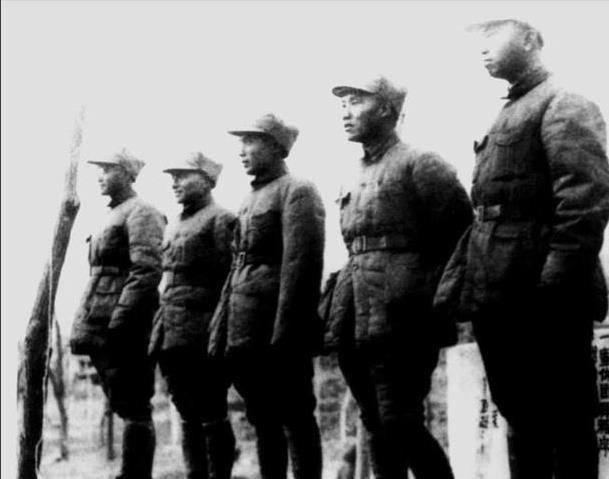Among the ten founding generals of New China, wang Shusheng is not prominent compared with Su Yu, Chen Geng and Xiao Jinguang in terms of battle achievements and military merits.
He used to be a screaming "tiger general", why did he become a "sheep" from the liberation war?

The core general of the Red Fourth Front,
In 1927, Wang Shusheng responded to the call of the revolution and actively participated in the revolution. At the time of the jute uprising, although he had never been a soldier, he was not nervous at all in the face of the enemy, and he put the enemy close and fought again, showing a certain military talent.
Although he led the soldiers to fight, he was a "layman", experienced several battles and slowly felt a little doorway, but he knew the method of "platooning and deploying troops".
When the Red Army was born in Eyuwan, he was incorporated into the 31st Division and became Xu Xiangqian's subordinate.
In 1930, Wang Shusheng served as the captain of the brigade, others could not chew the hard bones, he led the troops to wield a large knife to rush to kill, a charge pounced on the enemy, the battlefield captured more than 100 guns and bullets. The Red First Division ushered in a change, and he was promoted to detachment leader and regimental commander.
In the first battle of the new set, he formed a 120-man death squad, climbed the city wall and engaged the enemy in hand-to-hand combat, after the city gate was opened, he engaged the enemy, and the brother troops invaded the city. This battle made Wang Shu famous.
In the Battle of Shuangqiao Town, the Red Army fought for 7 hours, annihilating more than 5,000 enemy troops, and after the battle, Wang Shusheng was tired enough.
As the battles in the Eyu-Anhui Soviet Region became more and more fought, the Red Army continued to expand into three divisions, with Ni Zhiliang as the commander of the 10th Division, Wang Shusheng as the commander of the 11th Division, and Chen Geng as the commander of the 12th Division.
In 1932, the main force of the Four Fronts Army jumped out of the outer line to fight, and together with the main force, he opened up the Sichuan-Shaanxi base area, and made many military achievements in the anti-three-way siege and the anti-six-way siege. After the expansion of the Fourth Front, Wang Shusheng was promoted to commander and deputy commander of the Front, and became the core general of the Four Fronts.
During the Red Army period, Wang Shusheng was a tiger general on his battle achievements and military merits.
Since the outbreak of the War of Resistance Against Japanese Aggression, this tiger general began to become more and more low-key, and served as a deputy for a long time, such as deputy commander of the Jinji-Hebei Yu Military Region and deputy commander of the Taihang Military Region.
After the end of the War of Resistance Against Japanese Aggression, the Central Plains Military Region was established, and he served as the deputy commander of the military region and the commander of the 1st Column. During the breakthrough in the Central Plains, the troops dispersed to break through, and Pi Dingjun led more than 7,000 people to attract the enemy to break through to the east, and he led the troops to open up a base area in northwest Hubei.
Due to the harsh natural conditions in northwest Hubei and the difficulties of the troops, the superiors let Wang Shusheng partially disperse, Zhang Caiqian led a part to cross the Yangtze River south, and Liu Changyi led a unit to fight a guerrilla attack in Dabie Mountain. Wang Shusheng returned to the Liberated Areas to recuperate from illness due to illness, and traveled to Shanghai and Shandong to arrive at the garrison of the Jinji-Hebei Luyu Military Region.
In August 1947, when he learned that Liu Deng's army led four columns to leap thousands of miles into Dabie Mountain, he could not sit still, although his body had not yet fully recovered, he immediately wrote a report to the Party Central Committee and asked to return to Dabie Mountain with the army.
After arriving at Dabie Mountain, he opened up a base area, created the Eyu Military Region, and served as commander, playing a lot of roles in providing Liu Deng's army with a stable rear area.
When Liu Deng's army launched the Xiangfan Campaign, the Huaihai Campaign, the Battle of Crossing the River, and so on, Wang Shusheng only responded to the main battle, taking advantage of the enemy's empty strength and large county seats to deliver grain and soldiers to the front line.
Wang Shusheng has experienced more than twenty years of war, and he is no longer the young man who only dares to fight and fight. He considered the problem from the part to the whole, and wherever revolutionary work needed someone. Although he was very angry in his heart, he wanted to fight on the front line, after all, his body did not allow it.
During the Liberation War, Wang Shusheng appeared to be much more low-key than other large armies.